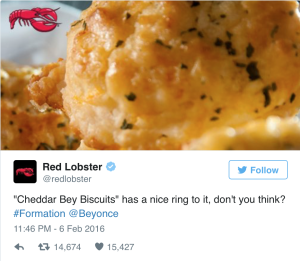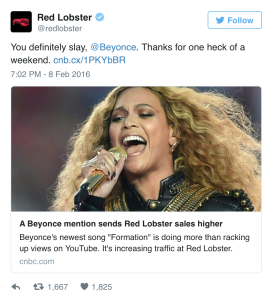The 2016 Super Bowl brought along its usual jaw dropping and unforgettable moments for consumer and spectators alike. But what we at CBC care about is how well those big-name Super Bowl advertisers reached their target audience. One way to monitor how well brands did in their advertising initiatives is to measure post-game mentions. For a lucky few brands, talk is still buzzing, and while most of the heavy hitters spent large sums of money to have that precious air time, some were able to grab attention for free. You might be wondering- how did they pull THAT off? It’s simple: product placement.
Product placement has been a notable advertising technique for quite some time. The obvious advantages of product placement are that your brand gets air time with respectable and trustworthy opinion leaders, allowing your brands reputation to become more credible. While most companies will pay to have their products featured in media programs, it’s not always the case. In a couple instances that are mentioned below, brands get credible airtime without spending a dime, allowing for great post-game coverage for their product of service. Here are some brands that are making viral waves post-game.
One of the biggest benefactors of this advertising technique would be Red Lobster. During Beyoncé’s half time performance, she mentions the chain restaurant in her new song. Red Lobster saw a spike in activity on their social media as well as a rise in sales since the release of the song just a day prior.

[Source]
Apple was another brand that didn’t pay for air time in any facet, but was instead including in advertising by other popular brands. The iPhone 6S, Apple’s CarPlay interface, the Apple Watch, and Beats Audio were able to make cameo appearances which spiked interest in Apple products associated with these brands. The cameo appearances were in a variety of product commercials from car companies like Hyundai, phone companies like T-Mobile, and Machine Zone’s Mobile Strike campaign.

[Source]
Budweiser was an unexpected benefactor of product placement after Peyton Manning said he was “going to drink a lot of Budweiser” after his super bowl win. An unfortunate circumstance for Budweiser who already spent millions of dollars in advertising fees, but nonetheless a credible and substantial push for their target media.

[Source]
Overall, this kind of advertisement is a luck of the draw approach: it isn’t the most reliable, and of course unlike paid advertisement, it’s never guaranteed. But as a PR professional, always be prepared for the unexpected, and if the instance occurs, make sure you thank those who gave you a shout-out!

[Source]
